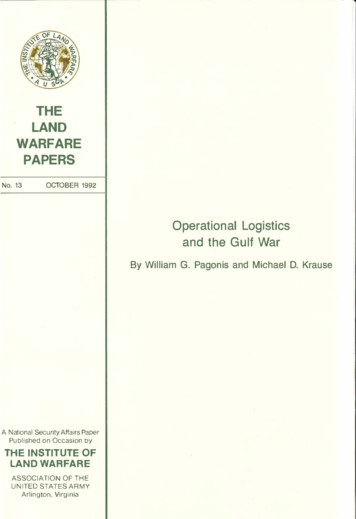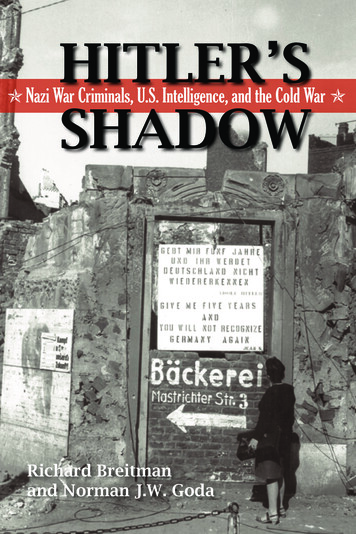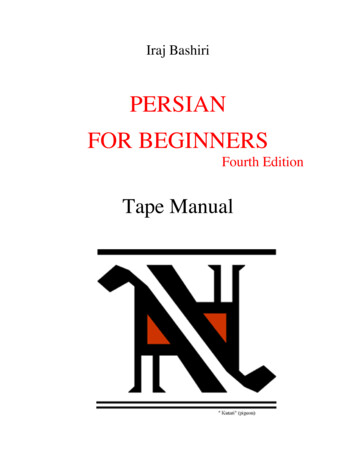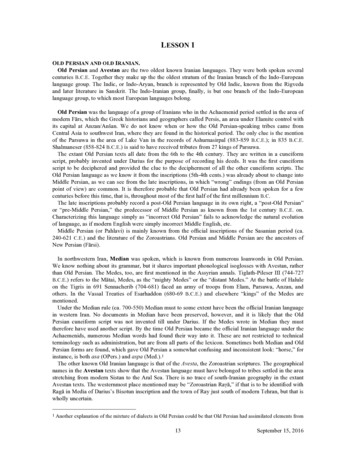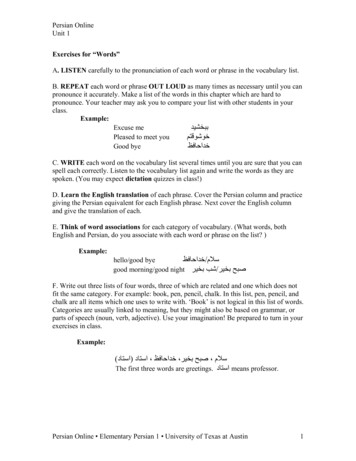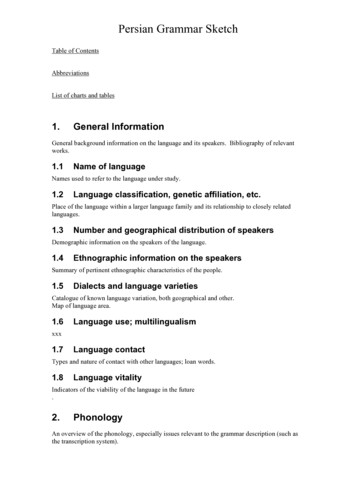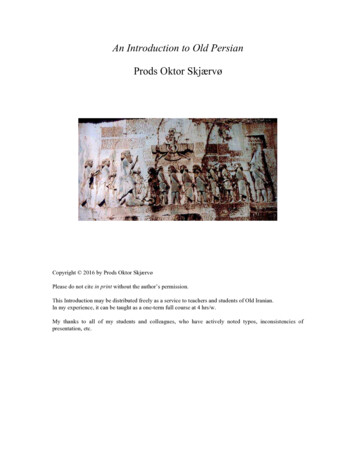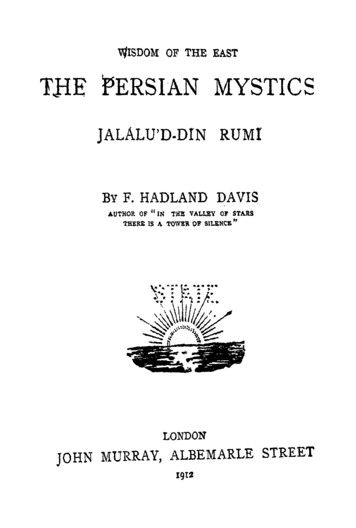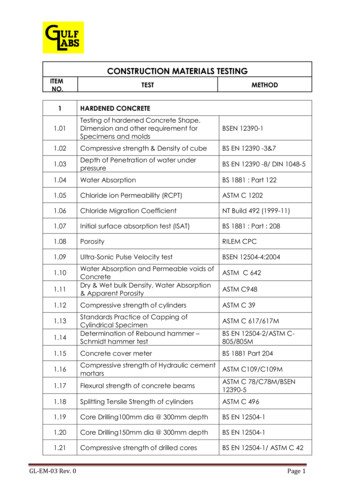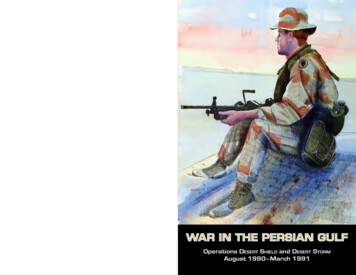
Transcription
War in the Persian GulfPIN : 909253–000Operations Desert Shield and Desert StormAugust 1990–March 1991
War in thepersian GulfOperationsDesert Shield and Desert StormAugust 1990–March 1991Center of Military HistoryUnited States ArmyWashington, D.C., 2010
Cover: On Guard at Sunset by Peter Varisano.CMH Pub 70–117–1First Printing
ContentsPageIntroduction. . . . . . . . . . . . . . . . . . . . . . . . . . . . . . . . . . . . . . . . . . . . .vStrategic Setting: The Army on the Eve of War in the Gulf. . . . . . . .Operations. . . . . . . . . . . . . . . . . . . . . . . . . . . . . . . . . . . . . . . . . . . . . .The First Deployments. . . . . . . . . . . . . . . . . . . . . . . . . . . . . . . . .Support of the Deployed Forces. . . . . . . . . . . . . . . . . . . . . . . . . .Host-Nation Support and Contracting. . . . . . . . . . . . . . . . . . . . .Transportation . . . . . . . . . . . . . . . . . . . . . . . . . . . . . . . . . . . . . . .“Deforger 90”. . . . . . . . . . . . . . . . . . . . . . . . . . . . . . . . . . . . . . .Mobilizing the Reserve Components. . . . . . . . . . . . . . . . . . . . . .Planning for the Offensive. . . . . . . . . . . . . . . . . . . . . . . . . . . . . .Operation Desert Storm . . . . . . . . . . . . . . . . . . . . . . . . . . . . . . .Attack on Khafji. . . . . . . . . . . . . . . . . . . . . . . . . . . . . . . . . . . . . .The 100-hour Ground War. . . . . . . . . . . . . . . . . . . . . . . . . . . . . .Day One: 24 February 1991. . . . . . . . . . . . . . . . . . . . . . . . . .Day Two: 25 February 1991. . . . . . . . . . . . . . . . . . . . . . . . .Day Three: 26 February 1991. . . . . . . . . . . . . . . . . . . . . . . .Day Four: 27 February 1991. . . . . . . . . . . . . . . . . . . . . . . . .Cease-fire. . . . . . . . . . . . . . . . . . . . . . . . . . . . . . . . . . . . . . . .Analysis. . . . . . . . . . . . . . . . . . . . . . . . . . . . . . . . . . . . . . . . . . . . . . .Epilogue . . . . . . . . . . . . . . . . . . . . . . . . . . . . . . . . . . . . . . . . . . . . . . .Abbreviations. . . . . . . . . . . . . . . . . . . . . . . . . . . . . . . . . . . . . . . . . . .Map Symbols . . . . . . . . . . . . . . . . . . . . . . . . . . . . . . . . . . . . . . . . . . .Further Readings. . . . . . . . . . . . . . . . . . . . . . . . . . . . . . . . . . . . . . . . .1358111217232729343435444957636467717375MapsNo.1. Desert Shield/Desert Storm Area of Operations: 1990–1991. . . viii2. Supplying the Troops: December 1990 . . . . . . . . . . . . . . . . . . . . . 143. Preparing for the Ground War: January–February 1991 . . . . . . . . 304. Ground War: Situation 24 February 1991 . . . . . . . . . . . . . . . . . . . 36iii
No.Page5. Ground War: Situation 25 February 1991 . . . . . . . . . . . . . . . . . . . 466. Ground War: Situation 26 February 1991 . . . . . . . . . . . . . . . . . . . 527. Ground War: Situation 27 February 1991 . . . . . . . . . . . . . . . . . . . 58IllustrationsGeneral H. Norman Schwarzkopf Jr. . . . . . . . . . . . . . . . . . . . . . . . .Lt. Gen. John J. Yeosock . . . . . . . . . . . . . . . . . . . . . . . . . . . . . . . . . .Lt. Gen. Gary E. Luck. . . . . . . . . . . . . . . . . . . . . . . . . . . . . . . . . . . . .The 82d Airborne Division at Pope Air Force Base. . . . . . . . . . . . . .Maj. Gen. William G. Pagonis. . . . . . . . . . . . . . . . . . . . . . . . . . . . . .Tapline Road. . . . . . . . . . . . . . . . . . . . . . . . . . . . . . . . . . . . . . . . . . . .Lt. Gen. Frederick M. Franks Jr. . . . . . . . . . . . . . . . . . . . . . . . . . . . .VII Corps assembly area in Saudi Arabia. . . . . . . . . . . . . . . . . . . . . .MOPP Medics in the Desert. . . . . . . . . . . . . . . . . . . . . . . . . . . . . . . .Troops training in trenches. . . . . . . . . . . . . . . . . . . . . . . . . . . . . . . . .Patriot missile battery. . . . . . . . . . . . . . . . . . . . . . . . . . . . . . . . . . . . .M1A1 Abrams tank. . . . . . . . . . . . . . . . . . . . . . . . . . . . . . . . . . . . . . .The 1st Armored Division pushes north. . . . . . . . . . . . . . . . . . . . . . .Desert Storm, 101st Style. . . . . . . . . . . . . . . . . . . . . . . . . . . . . . . . . .Multiple-launch rocket system battery. . . . . . . . . . . . . . . . . . . . . . . .Night Attack . . . . . . . . . . . . . . . . . . . . . . . . . . . . . . . . . . . . . . . . . . . .Burning oil fields in Kuwait. . . . . . . . . . . . . . . . . . . . . . . . . . . . . . . .456710162122232833404349515563Illustrations courtesy of the following sources: pp. 7, Randall M.Yackiel; 16, LaDona S. Kirkland; 22, 33, 40, 43, 51, 63, Defense VisualInformation Directorate; 28, Randall R. Anderson. All other illustrationsfrom Department of the Army files.iv
IntroductionAlthough now twenty years in the past, the events surrounding theinvasion of Kuwait by the forces of Saddam Hussein in August 1990 andthe subsequent U.S.-led coalition that ejected the Iraqis from that smallnation are key to understanding today’s situation in the Middle East.For the first time, the United States was directly and openly involved insending major land forces to Saudi Arabia and the Persian Gulf region.For the first time since the fall of the Berlin Wall, the U.S. Army, whichhad trained to fight Soviet forces in Central Europe, moved a large portionof those forces to engage in open warfare in a completely different theateragainst a former Soviet client state. The overwhelming success of thoseendeavors, Operations Desert Shield and Desert Storm, renewed theconfidence and assertiveness of the United States in its foreign policy inthe Near East and throughout the world.Other elements of what later became known as the first Gulf Waralso remain with us. American troops stayed in the region for over twodecades, first containing a resurgent Saddam Hussein and then dealingwith his aftermath. Equally important, the coalition partnerships cementedin that initial operation and in the regional peacekeeping operations thatfollowed provided the basis for a growing series of multinational effortsthat have characterized the post–Cold War environment. Finally, thegrowing interoperability of U.S. air, sea, and land forces coupled with theextensive employment of more sophisticated weapons based on advancedelectronic technologies, first showcased in Desert Storm, have becomethe hallmark of American military operations and the standard that othernations strive to meet.This pamphlet, prepared by the Center’s Chief Historian, Dr. RichardStewart, is based primarily on two works. The first is the Center’s TheWhirlwind War: The United States Army in Operations Desert Shieldand Desert Storm, Frank N. Schubert and Theresa L. Kraus, generaleditors, prepared about a year after the events in question. The secondis a chapter written by Brig. Gen. John Sloan Brown (former Chief ofMilitary History, now retired) in the Center’s comprehensive history ofthe U.S. Army, American Military History, vol. 2, The United StatesArmy in a Global Era, 1917–2008. I hope that soldiers of all ranks willv
enjoy this short account of a conflict that twenty years ago captured theattention of the world as the first test of the U.S. Army since the VietnamWar and its first large-scale armor engagement since World War II.Washington, D.C.28 May 2010JEFFREY J. CLARKEChief of Military Historyvi
War in thepersian GulfOperationsDesert Shield and Desert StormAugust 1990–March 1991
D E S E R T S H I E L D / D E S E R T S TO R MBAGHDADTigAREA OF OPERATIONS1990–1991risRiveAir Baser0150MilesIEuphratRes RiverAQIAs SamāwahRANAhvāzAn NāşirīyahTALLILKhorramshahrAl BaşrahJALIBAHAbādānK U W A I TALI AL SALEM AIRBASEKUWAITKUWAIT INTERNATIONALAr RuqīAHMED AL JABERAIRBASEādīalBāţinRAFHAWRa’s al KhafjīḨafar al BāţinP E R S I A NG U L FQAISUMAHRAS MISHABKING KHALID MILITARY CITYJUBAYLAl JubaylKING ABDUL AZIZ AIRBASEKING FAYD INTERNATIONALBURAYDAHAL ARTAWIYAH SOUTHS A U D IAd DammāmDhahranDHAHRAN INTERNATIONALA R A B I AKING KHALID INTERNATIONALRIYADH INTERNATIONALMap 1RIYADH
War in the Persian GulfOperations Desert Shield and Desert StormAugust 1990–March 1991In the early morning hours of 2 August 1990, Iraqi dictator SaddamHussein launched an overwhelming invasion of tiny, oil-rich Kuwait.(Map 1) The United States Army, reveling in the end of the Cold Warand on the verge of downsizing, faced a new and unexpected challenge.The fall of the Berlin Wall on 9 November 1989 had changed thestrategic equation, not only in Europe but throughout the world. Withina few years, Soviet troops evacuated all of their former satellites in theWarsaw Pact, those satellites reconfigured themselves as independent anddemocratic states, the Soviet Union itself collapsed into fifteen differentcountries, and Germany reunited into a single nation. This collapse leftthe United States as the sole remaining superpower in a new, unsettledworld. The United States came to have more responsibilities around theglobe and more strategic maneuver room to intervene in foreign criseswith less risk of catastrophic confrontation with the Soviet Union. Atthe same time, client states of the former Soviet Union—from EasternBloc Europe to Cuba to the Middle East—found themselves without theirtraditional patron and without the military and diplomatic restraint thatpatron-client relationship had provided in the past. One former Sovietclient, the Ba’athist Iraq of Saddam Hussein, certainly felt empoweredto press its luck.Strategic Setting: The Army on the Eve of War in the GulfThe Army at the end of the Cold War was a very different institutionthan the one that had emerged from the sting of defeat in Vietnam less thantwo decades before. That earlier Army, its confidence in ruins and struggling to rebuild itself as a volunteer force, virtually reinvented itself fromthe bottom up. Employing new doctrine, reinvigorated leadership, renewedemphasis on realistic training, and a full-court press to rearm and reequipitself to fight a modern war anywhere in the world, the Army in 1990 wassmall (in comparison with the army of the Vietnam era), highly trained,and fully professional. It was a high-quality force prepared to fight anintense war against a first-class foe. However, the collapse of Soviet power
and withdrawal of Soviet armies into the Soviet Union, the disintegrationof the Warsaw Pact, and the dismemberment and disappearance of theSoviet Union seemed to many to remove the justification for maintaininga powerful U.S. Army. Political leaders sought a “peace dividend,” andthe Army projected budgets that would decrease the number of its activeservice members from seven hundred eighty thousand in 1989 to fivehundred thirty-five thousand in 1995. Some Americans believed long-termpeace was the order of the day and that we could dismantle our “bloated”military establishment. That “bloated” establishment would soon show theworld how effective, and needed, it was. The United States would sendthe best-prepared force America had ever deployed in response to nakedaggression in the Persian Gulf.As Saddam Hussein’s attack unfolded, three armored divisions ofthe elite Iraqi Republican Guard crossed the Kuwaiti border and spedtoward the capital city. The several brigades and potpourri of militaryequipment of the hapless Kuwaiti Army, already disorganized by attacksfrom Iraqi special operations forces, proved no match for this assault.Within days, the Kuwaitis had surrendered or fled to Saudi Arabia, theRepublican Guard divisions had closed to the Saudi border, and Iraqifollow-on forces had fanned out to secure the oil fields and commercialwealth of the small but prosperous country. Iraq had long coveted oilrich Kuwait, characterizing it as a nineteenth province the British hadpurloined during the colonial era. Iraq’s ambition had become aggravatedduring the prolonged, desultory Iran-Iraq War (1980–1988). Husseinhad accrued enormous debts fighting the Iranians, leaving him with alarge and battle-hardened army but an economy in disarray. The wealthof Kuwait, in his mind, could fix this problem.Hussein’s army had grown tenfold during the war with Iran. Whenfully mobilized, it numbered over a million soldiers. Perhaps moreimportant, it was well equipped by the virtue of huge purchases frominternational arms markets. Although most of this equipment was ofSoviet design and a generation behind its American counterparts, thesheer numbers of tanks, armored fighting vehicles, artillery pieces, andsmall arms of all types made it formidable. Although the Soviet Unionwas no longer available to assist Iraq internationally, Hussein couldcount on support among the most polarized or disaffected elements ofthe Arab World. Iraq’s standing as a “Sunni Shield” against the powerof resurgent Shi’ite Iran made many Arab states loath to confront himdirectly. For many in the region, Kuwait was seen as little more thanan American dependency, and defiance of Israel’s ally America wasrighteous in many Arabs’ eyes.2
For the American government and President George H. W. Bush,the first priority quickly became the defense of Saudi Arabia. Disruptionof Kuwaiti oil supplies was damaging enough to the global economy;disruption of Saudi oil supplies could be disastrous. The Saudis sharedBush’s view, and their leadership overcame an established nationalantipathy toward allowing foreign troops into their kingdom. On 6August, Saudi King Fahd bin Abdul Aziz al-Saud formally approvedAmerican intervention to assist in the defense of his kingdom.U.S. forces rapidly began to move to Saudi Arabia. Initial forcesincluded two F–15 squadrons; Maritime Pre-positioned Squadrons 2 and3, based on the islands of Diego Garcia and Guam; two carrier battlegroups; the ready brigade of the 82d Airborne Division; and an airbornewarning and control system (AWACS) unit. Much more would follow.Secretary of Defense Richard B. Cheney, at the direction of PresidentBush, unleashed what became arguably the most concentrated andcomplex projection of American military power since World War II.The initial missions of these forces were to protect Saudi Arabia and theSaudi oil fields from Iraq and to prevent further aggression. No decisionhad yet been made to turn that defensive mission into an offensive oneto roll back Iraqi gains.OperationsThe first days of August began an anxious several weeks for Americandefense planners, especially after the 82d Airborne Division’s readybrigade arrived on the scene. The staff of the U.S. Central Command(CENTCOM), commanded by General H. Norman Schwarzkopf Jr.,knew the levels of risk they undertook as they sought to balance the proportions of support and combat troops coming into theater. Recognizingthe enormous armored wherewithal of the Iraqis just across the border,the lightly armed paratroopers of the 82d characterized themselves as“speed bumps,” intended at best to delay an Iraqi attack—and to signalthe determination of the United States to defend Saudi Arabia withAmerican lives. This in turn would buy time for the buildup of forces.Every effort was made to effect a rapid buildup of combat powerand logistical support. Although U.S. forces were at risk for a number ofweeks, compared to historical precedent the American buildup in SaudiArabia progressed quickly and efficiently. In a little over two months,the powerful XVIII Airborne Corps, consisting of an airborne division,an air-assault division, two heavy divisions, an armored cavalry regiment(ACR), and the requisite array of combat support (CS) and combat servicesupport (CSS) assets, had deployed. The arriving inventory included3
over 120,000 troops, 700 tanks,1,400 armored fighting vehicles,and 600 artillery pieces. This is notto mention the 32,000 troops and400 tanks provided by local Araballies. Hundreds of planes werein theater operating out of Saudi,Turkish, and Qatari airfields, withmore operating off of Americanaircraft carriers and long-rangebombers able to range the theaterfrom Diego Garcia and even fromthe United States. The Navy was onhand and active in the Persian Gulfand its approaches, having alreadyimposed an effective blockadeon Iraq. The risk of Iraqi attackreceded after the first few weeks,General Schwarzkopfbut the need to prepare for anyeventuality remained.How to use the newly arriving forces to best effect was a criticalconcern. Although Central Command had contingency plans to defendSaudi Arabia from the Soviet Union or its allies from the earliest daysof the Rapid Deployment Joint Task Force created in 1979, these planswere not up to date. Central Command and its service componentcommands worked on a unified campaign plan for the defense of SaudiArabia during much of 1990, primarily via a computer-facilitated wargame entitled Internal Look 90. The simulation yielded considerableinsight, but plans were incomplete and had not yet been presented to theJoint Chiefs of Staff or the services for review. Lack of an approved planproved especially significant during the fluid situation of August. Had anapproved unified campaign plan been in place, it would have provided tothe services detailed lists of force requirements. It took time to identifyrelevant requirements and then to match these requirements with specificunits. The problem became particularly acute when identifying themany separate units needed to support a large force in the desert: waterpurification companies, tactical petroleum terminal units, engineer realestate detachments, and medium-truck companies. Deployment lists driveservice access to reserve capabilities. This in turn becomes contingent onpolitical decisions by the president to mobilize the necessary reserves.During 10–28 August, more than twenty messages altering troop lists4
on the original deployment orderpassed between Central Commandand the Pentagon, reflecting thecomplexity of identifying specificunits based on requirement, availability, and component.Operation Desert Shield was amajor test for Army logistics. TheArmy component (ARCENT—U.S. Army Central Command)commander, Lt. Gen. John J.Yeosock, arrived in Saudi Arabiaon 6 August to oversee the massive effort. With a handful ofstaff officers, he set up an interimheadquarters in the Saudi capitalof Riyadh to supervise the arrival,sustainment, and overall planningGeneral Yeosockfor deploying Army units. UntilGeneral Schwarzkopf arrived inthe theater on 25 August, General Yeosock also helped CENTCOM’sacting deputy commander in chief, Lt. Gen. Charles A. Homer, U.S. AirForce, coordinate the arrival of the joint force. Yeosock knew the terrainand climate and was familiar with his Saudi hosts. From 1981 to 1983,he had served in Riyadh as project manager for the modernization ofthe Saudi Arabian National Guard, and this experience would serve himwell in the months ahead.The First DeploymentsThe first units of the XVIII Airborne Corps began deploying to SaudiArabia on 8 August. The rapid deployment of the ready brigade of the 82dAirborne Division clearly signaled a U.S. national commitment to deterfurther Iraqi aggression. The brigade took its light antitank weapons andM551 Sheridans, armored reconnaissance vehicles that provided someantiarmor capability with a 152-mm. main gun and MGM–51 Shillelaghantitank missile. The paratroopers would be at considerable risk shouldIraq decide to invade Saudi Arabia before the United States completedits force buildup. Nevertheless, the decision drew “a line in the sand.”The XVIII Airborne Corps, ordinarily headquartered at Fort Bragg,North Carolina, served as the Army’s contingency corps. This missionrequired that it be ready to deploy on demand. Lt. Gen. Gary E. Luck5
had assumed command of thecorps in July 1990 and was adecorated veteran of Vietnam andformer commander of the JointSpecial Operations Command.Under General Luck’s leadership, the XVIII Airborne Corpsprovided command and controlto the 101st Airborne Division(Air Assault), the 24th InfantryDivision (Mechanized), and the82d Airborne Division. The 101stAirborne Division, stationed at FortCampbell, Kentucky, was in effecta light infantry division trained todeploy and assault by helicopter.The 24th Infantry Division, locatedat Fort Stewart, Georgia, served asGeneral Luckthe XVIII Airborne Corps’ heavydivision. A heavy division such asthe 24th relied upon the speed, flexibility, mobility, and firepower of itstracked vehicles: armored personnel carriers, infantry fighting vehicles,self-propelled artillery, and main battle tanks. The 82d Airborne Division,the Army’s premier light contingency force, routinely had one of itsbrigades designated as its ready brigade. This was the first to go to thePersian Gulf.The first elements of the 82d’s ready brigade departed Pope AirForce Base, adjacent to Fort Bragg, early in the afternoon of 8 August1990 and arrived at Dhahran, Saudi Arabia, the following day. Theseimmediately established defenses around the airfield to provide securityfor later-arriving units. As additional troops came into the country, theperimeter expanded. By the afternoon of 13 August, when the readybrigade reported 100 percent of its troops deployed from Fort Bragg and88 percent of them already in Saudi Arabia, it had expanded its area ofoperations to provide security to Al Jubayl, the port through which theU.S. Marines would enter the theater.The other two brigades of the 82d quickly followed the ready brigade. On 13 August, the 1st Brigade deployed an advance party, whicharrived in Saudi Arabia two days later, and completed its deployment onthe twentieth. The 3d Brigade began its deployment on 19 August andcompleted it on the twenty-fourth. Around this time, selected elements of6
Troops of the 82d Airborne Division loading onto a C5B GalaxyTransport at Green Ramp, Pope Air Force Base, North Carolinathe XVIII Airborne Corps Support Command moved into Saudi Arabiato begin building the necessary logistical infrastructure.While establishing defensive positions and conducting patrols, thesoldiers began the long process of adapting to the environment. Theirleaders carefully watched water consumption. The soldiers initiallytrained and worked only at night, in the early morning, and in the lateafternoon to limit exposure to the searing desert sun. The sand madeits way into everything—weapons, vehicles, clothing, and food—andconstant attention was required to make sure equipment and weaponswould work when they were needed. Although the corps’ personnelflew to Saudi Arabia, most of their heavier equipment moved by ship.The transshipment of materiel continued through August and Septemberfrom five Atlantic and Gulf of Mexico ports. Corps support units loadedat Wilmington, North Carolina.Other Army units with more specialized, yet critical missions quicklyfollowed the 82d into Saudi Arabia. Special Forces planners who accompanied the 82d Airborne Division began preparing for the arrival of the 5thSpecial Forces Group (Airborne). In addition, the lead elements of the 7thTransportation Group from Fort Eustis, Virginia, started their movementto the ports. That unit would control port operations and the unloading ofequipment from ships once they docked in Saudi Arabia. On 14 August,the commander of the 11th Signal Brigade arrived in theater and beganestablishing an Army communications network. The first elements of7
a Patriot missile battery of the 11th Air Defense Artillery Brigade alsodeployed in early August, and another battery from the 7th Air DefenseArtillery Regiment arrived in Saudi Arabia on 16 August. The following day, the first aviation elements of the 101st Airborne Division andadvance elements of the 24th Infantry Division arrived in theater. By theend of the first week of Desert Shield, more than 4,000 Army soldiershad deployed to Saudi Arabia on 106 aircraft. Major weapon systemsaccompanying the soldiers included 15 AH–64 Apache helicopters, 8OH–58 Kiowa observation helicopters, 18 M551 Sheridan light tanks,56 tube-launched optically tracked wire-guided (TOW) antitank missilesystems, 2 multiple-launch rocket system (MLRS) launchers, and 12105-mm. towed howitzers.Although the Desert Shield forces continued to deploy at a steadypace, General Schwarzkopf needed more firepower. In the early weeksof the deployment, he anxiously awaited the arrival of the 24th InfantryDivision (Mechanized) with its 216 M1A1 Abrams tanks. Despite therapid movement of the Army’s first combat units into Saudi Arabia, timeand the initiative remained with Iraq. Saddam Hussein had six divisionsavailable in Kuwait to launch into Saudi Arabia with no warning if heso chose.Support of the Deployed ForcesThe flow of the XVIII Airborne Corps’ combat forces into SouthwestAsia somewhat overshadowed the deployment of combat service supportforces. General Luck understood the need for an adequate support structure, an imperative considerably magnified by the austere environment ofSouthwest Asia. Army divisions did have organic logistical organizationscapable of supporting them for limited periods. When their defensivepositions were near the ports, combat units could use organic capabilities to transport supplies to and process them in locations in the field.Eventually, however, the distance and sheer volume would overwhelmtheir ability to process, move, store, maintain, and account for materiel.Such operations also would detract from their primary defensive mission. For sustained operations and a stay of over thirty days, the ArmyCentral Command needed a mature logistical system. However, thecountervailing need to forestall possible surprise attacks by the Iraqisdrove priorities and taxed the system. The XVIII Corps reported on thethird day of its deployment, “The combination of moving combat forcesas rapidly as possible as well as essential service support from the Corpshas generated requirements which exceed limited resources immediatelyavailable to the corps.”8
As General Yeosock and the ARCENT staff had rehearsed in theCommand Post Exercise Internal Look 90, they planned on initiallydeploying only a minimum of essential support units and creating alimited logistical base. Priority of deployment would go to combat forces.Only later and if necessary would a mature logistics infrastructure bedeveloped. Hence, when XVIII Airborne Corps units arrived in theater,logistical support was virtually nonexistent. The corps support unitsthat were arriving quickly discovered they could not effectively handlethe massive deployment of combat troops, who needed the full rangeof support: food, shelter, equipment, supplies, sanitation facilities, andtransportation. General Yeosock realized the need to expand the supportsystem rapidly.Maj. Gen. William G. Pagonis, whom General Yeosock appointed asARCENT’s deputy commander for logistics, led the logistical buildup.Pagonis landed in Riyadh on 8 August, scant hours before the firsttransport carrying the ready brigade of the 82d Airborne Division hitthe tarmac at Dhahran, two hundred fifty miles away. While en route toSaudi Arabia, Pagonis and his small staff (initially just four officers, laterexpanded to twenty-two) drafted a logistics plan for the theater. All hadparticipated in the Cold War’s Return of Forces to Germany (Reforger)exercises, which provided a model for their Desert Shield plan. Thegroup outlined three major tasks necessary to create a sound logisticssystem in theater: the reception, onward movement, and sustainment ofsoldiers, equipment, and supplies.When Pagonis arrived at Dhahran, he was appalled at what he found.Combat troop arrivals had quickly overwhelmed the local resources.Lt. Col. James Ireland on Pagonis’ staff later recalled that as soldierspoured in, “we just didn’t have anything. We had . . . soldiers here withno place to put them, no way to get them out there if we did have a placeto put them, and difficulty feeding them.” Soldiers slept on the sandand on handball and tennis courts. Hundreds slept on the ground behindthe quarters occupied by the U.S. Military Training Mission to SaudiArabia and dug slit trenches for latrines. Three American officers fromthe training mission frantically tried to process the incoming soldiersfrom the XVIII Airborne Corps, who had started to arrive late in themorning of 9 August. The training mission had no significant transportation resources of its own, so the officers arranged for Saudi buses andtrucks to take the troops to a vacated air-defense facility fifteen milesfrom the airport. With no personnel, no facilities, no resources, andvery little information, those three officers made the best of a bad situation and provided whatever support they could; but the overwhelming9
demands quickly took a physicaltoll. His staff officers “looked likezombies,” Pagonis later recalled.“They hadn’t slept for . . . days.”On 11 August, the arrival ofthe 7th Transportation Groupimproved the situation, and soona handful of active-duty soldiersand recalled reservists created anad hoc logistical structure.Pre-positioned stocks of equipment aboard ships stabilized mostof the immediate crises in supplyingand sustaining the new arrivals. Fourships that had been anchored offthe coast of Diego Garcia broughtrations, cots, tents, blankets, andGeneral Pagonismedical supplies, as well as refrigerated trailers, reverse-osmosiswater-purification units, forklifts, and tactical petroleum terminals. Thoseships, which had been stocked and positioned so they could support anexpeditionary force such as the one now deploying, arrived at Saudi Arabianports on 17 August. They bought time for Pagonis to stand up a more formallogistics system. “There was no doubt about it,” Pagonis later said. “Wewould have never made it if we did not have those four Army pre-po ships.”By the end of August, General Pagonis’ staff, now configured asa Provisional Support Command, was gaining control of the situation.They built the logistics infrastructure while si
peace was the order of the day and that we could dismantle our “bloated” military establishment. That “bloated” establishment would soon show the world how effective, and needed, it was. The United States would send the best-prepared force America had ever depl
